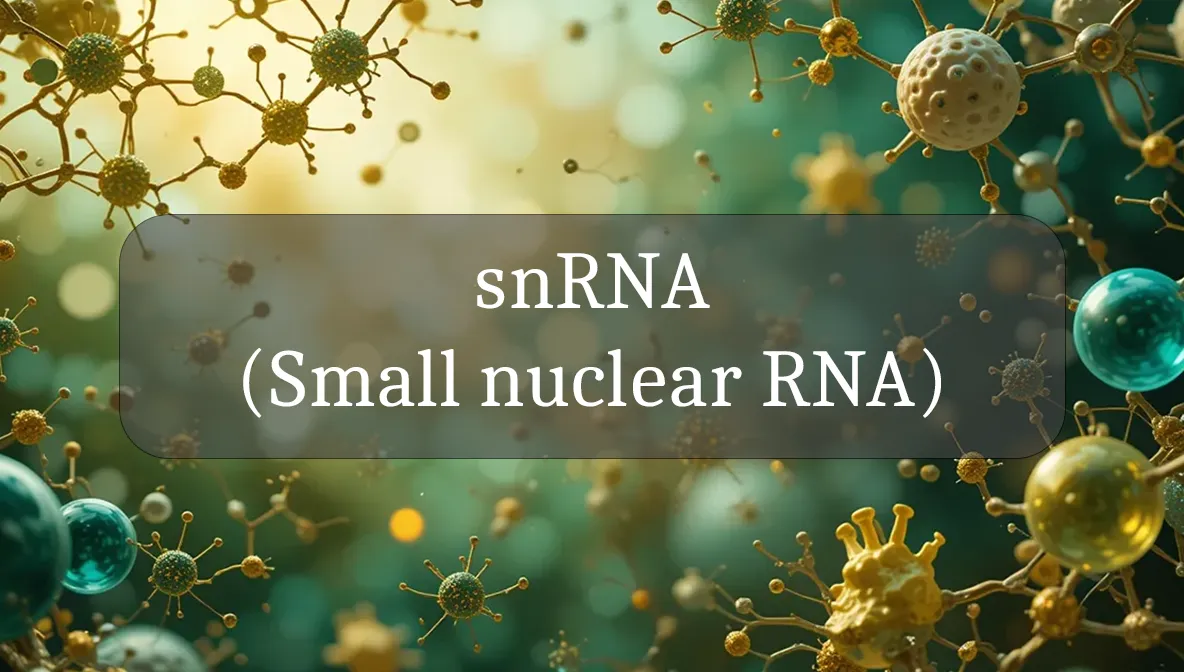The Tiny Editors of Your Cell’s Blueprint
Small nuclear RNA, or snRNA, might sound like a complex science term, but it’s really a group of tiny molecules in your cells that act like skilled editors, helping refine the instructions your DNA sends out to build proteins. These little helpers ensure your cells work smoothly, supporting your energy, immunity, and overall wellness. For health-conscious folks, understanding snRNA can inspire choices that boost your cellular health and long-term vitality. Let’s explore what snRNA is, why it matters, and how you can support it for daily wellness!
Chemical Identity and Type
Small nuclear RNAs (snRNAs) are short RNA molecules, typically 100–300 nucleotides long, found in the nucleus of your cells. They’re key components of a structure called the spliceosome, which acts like a molecular editing team. SnRNAs help “splice” or edit messenger RNA (mRNA) by removing unnecessary parts and stitching together the pieces needed to make proteins. Think of snRNA as the editor-in-chief, ensuring your cell’s protein-making instructions are clear and accurate.
Biological Role and Benefits
SnRNAs are essential for your body’s health and resilience:
- Protein Production: They help edit mRNA, ensuring your cells make the right proteins for muscle growth, tissue repair, and enzyme function.
- Cell Efficiency: By refining mRNA, snRNAs support smooth cell operations, keeping energy and balance in check.
- Immune Support: SnRNAs indirectly aid immune protein production, helping you fight off germs and stay healthy.
- Brain Health: They support accurate protein synthesis in brain cells, promoting memory, mood, and cognitive function.
- Metabolic Balance: SnRNAs help cells process nutrients efficiently, supporting energy and overall wellness.
Healthy snRNA function ensures your cells can produce precise proteins, boosting your strength, immunity, and vitality.
Dietary or Natural Sources
You don’t get snRNA from food—it’s made naturally by your cells. But you can support snRNA production and function with these nutrient-rich choices:
- Antioxidant-Rich Foods: Berries, leafy greens, and nuts (high in vitamins C and E) protect cells from damage, supporting snRNA stability.
- Protein-Rich Foods: Eggs, fish, beans, and lean meats provide amino acids for protein synthesis, which snRNAs support.
- B-Vitamin Foods: Whole grains, spinach, and lentils supply folate and B6, which aid RNA and protein processes.
- Magnesium-Rich Foods: Nuts, seeds, and dark chocolate provide magnesium, which supports nuclear processes and snRNA activity.
A balanced diet creates a cell-friendly environment for snRNA to do its job.
Signs of Imbalance or Dysfunction
SnRNA dysfunction is hard to detect directly, but issues with mRNA splicing or protein production may show up as:
- Fatigue: Low energy due to disrupted protein synthesis for energy or repair.
- Weak Immunity: Frequent infections or slow recovery, as snRNAs support immune protein production.
- Slow Healing: Wounds or muscles taking longer to recover due to faulty protein synthesis.
- Brain Fog: Trouble with focus or mood, as snRNAs aid brain cell function.
- Aging Signs: Premature wrinkles or low energy, as snRNAs help cells stay resilient.
These symptoms can have many causes, so if they persist, consult a healthcare provider to explore cell health or other issues.
Supporting Optimal Levels or Function
To keep your snRNA working well, try these evidence-based tips:
- Eat a Balanced Diet: Include lean proteins, colorful fruits, and whole grains to provide nutrients for snRNA and protein synthesis.
- Exercise Regularly: Moderate activities like walking, yoga, or strength training boost cell health and protein production.
- Prioritize Sleep: Aim for 7–9 hours of quality sleep to allow cells to repair and maintain RNA processes.
- Manage Stress: Meditation, deep breathing, or journaling can lower stress hormones that disrupt snRNA function.
- Limit Toxins: Avoid smoking, excessive alcohol, or processed foods, which can harm cells and RNA.
Small, consistent habits support snRNA and keep your cellular editing team thriving.
Safety, Interactions, and Precautions
SnRNA is a natural part of your cells and safe, but certain factors can disrupt its function:
- Oxidative Stress: Too many free radicals (from poor diet or pollution) can damage RNA. Eat antioxidant-rich foods to counter this.
- Chronic Stress: High cortisol levels may interfere with snRNA’s role in mRNA splicing. Practice daily stress relief.
- Environmental Toxins: Pollutants or UV exposure can harm cells and RNA. Use sunscreen and choose organic produce when possible.
- Medications: Some drugs, like certain chemotherapy agents, may affect RNA processes. Discuss medications with your doctor.
Protecting snRNA means minimizing these stressors and prioritizing cell-friendly habits.
Fun Fact
Did you know snRNAs are like molecular tailors? They help “cut and sew” mRNA in a process called splicing, ensuring your cells get perfectly tailored protein instructions every time!
Citations
- National Institutes of Health (NIH): Small Nuclear RNAs and RNA Splicing.
- Mayo Clinic: Protein Synthesis and Cellular Health.
- Cleveland Clinic: Nutrition and Cell Function.
- World Health Organization (WHO): Diet and Chronic Disease Prevention.
- USDA: Dietary Guidelines for Americans – Nutrient-Dense Diets.

